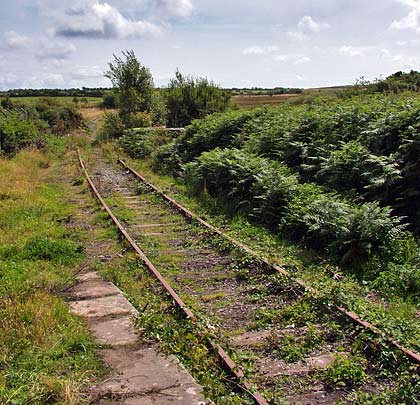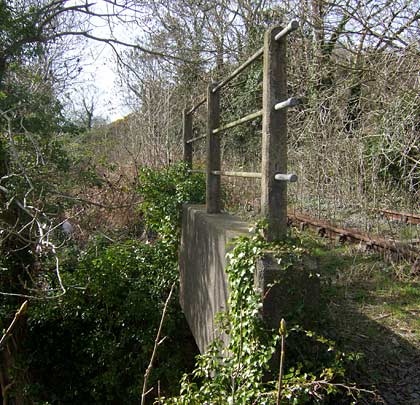Amlwch branch
Amlwch branch




















In 1852 the LNWR made a survey of the land between Gaerwen and Llangefni with a view to building a line between the two villages. The reason is not known but the survey report quoted that it was “not worth building”. The station at Gaerwen was mid way between the main line stations of Holyhead and Bangor and the survey had been commissioned before the main line had been connected via the Britannia tubular bridge across the Menai Straits.
Six years later in 1858, a public meeting in Llangefni was held to publicise the building of a railway between Gaerwen and Amlwch and also to build another line down the west of the island of Anglesey to join the LNWR main line at the small village of Valley. The latter proposal was not carried forward. Nothing more was heard of the scheme until 1861 when a Mr David Davies and partner offered to build a line from Gaerwen to Amlwch at a cost in the region of £6,000 per mile. The LNWR was approached with the idea and promptly turned it down. Thus the Anglesey Central Railway was born. It was incorporated in 1863 with a capital investment of £120,000.
The first sod cut was in September 1863 and work on the 4½ mile section between Gaerwen and Llangefni started in early 1864. This was completed and opened to freight traffic by December of the same year. Passengers were welcomed in March 1865. Rolling stock was loaned from the LNWR and, between March and December of the opening year, the passenger counts totalled almost 20,000 and the freight tonnage 4,000.
After some initial concerns, finance was raised to build the line through to its proposed terminus at Amlwch. The initial survey was finalised in January 1867 and the remaining 13¼ miles completed by June of the same year. The line was single track throughout with the only passing point being at Amlwch. The copper mines at Parys Mountain in Amlwch – once the world’s biggest exporters of Copper ore – used the railway from 1867 onwards but the mines had long since passed their peak of operation and closed in 1871. Most of the line’s freight revenue came from local farmers and fertilizer firms.
In 1868 the line’s owners, Mssrs Dickinson & Russell, found themselves in financial difficulties and asked the LNWR to operate the line. This request was turned down but agreement was reached on the hiring of a locomotive and stock to continue services. This continued until 1876 when the LNWR withdrew the agreement. As the ACR was unable to buy the loaned stock, arrangements were made for the company to be sold to the LNWR itself.
The LNWR immediately surveyed the line and found it to be in a poor condition and, over the coming years, replaced the neglected parts of the infrastructure. Loops were put in at Llangefni and Llanerchymedd, a loco shed built at Amlwch and the wooden station buildings at Holland Arms, Rhosgoch and Llangwyllog were replaced by purpose-built brick structures.
In 1877 a flash flood caused the dam of the Rhodgeidio water mill to overflow and the resulting torrent washed away the wooden Cae Mawr (big field) bridge over the River Alaw. The first train of the day was derailed and ended up on its side. The driver was fatally injured and a travelling loco inspector was scalded to death. The fireman and guard were both hurt but survived. The bridge was replaced by a stone structure and is known by locals as Pont Damwain (Accident Bridge).
As trains were now getting slightly longer, a passing loop was added to the line at Llangwyllog in 1914. This was ideal for the summer services and saved on waiting times to and from Amlwch. The frequency of services was increased to seven Up and six Down trains a day. However this was not to last long as the resources were needed elsewhere to maintain troop and freight movements for the war effort. The number of services were cut slightly and did not improve until the mid 1930s when, under its new owners the LMS, they were increased to ten Down and eight Up trains daily, increasing to 11 each way on a Saturday.
In 1948 the line was incorporated into British Railways and, in 1953, it trialled AEC rail motor units on through services to Bangor. Passengers going to Holyhead still had to change at Gaerwen. The services were well received but the units were criticised for their uncomfortable ride and were not popular. BR introduced the Derby Lightweight Diesel multiple units in 1956 and these proved extremely reliable and popular with passengers, particularly because of the ‘drivers eye view’ of the line ahead.
Summer timetables in 1963 and ‘64 were steam-worked as the DMU units were used elsewhere due to shortages of the class. In the early 1950s, the Associated Octel Company opened a factory to extract bromine from sea water – of which there was plenty – to make engine anti-knock compound for the motor industry. This involved the use of chlorine which was shipped from Cheshire by rail on a daily basis. Exchange sidings were built outside the town and supplied by a light railway, the bromine being returned by the same train.
The line closed to passenger traffic in 1964 under the Beeching cuts. The stations were shut and all the sidings and passing loops closed. The Associated Octel Company was the only user of the line which was left in place solely for its use. The light railway was closed and BR engines permitted to shunt into the plant.
The line remained in this situation for many years until the mid ‘70s when a new siding was built at Rhosgoch by Shell UK to transport steel and other materials needed to build a vast tank farm, used to store oil that had been pumped ashore by tankers moored off Amlwch. This farm was a storage facility for the oil which was pumped direct to Stanlow refinery in Cheshire via a 127 km underground pipeline. The tank farm closed in the early 1990s due to the decline of using very large crude oil tankers.
The last train from the Octel plant ran in 1993 due to the conversion to road haulage and the plant eventually closed in 2003. Passenger specials have been run on many occasions, the last being in 1993. Since then, the line has fallen into disrepair and is heavily overgrown in parts.
The junction at Gaerwen has recently been levelled and the ground covered with slate waste to form a hard standing which creeps suspiciously around the bend and onto the start of the line. This adds fuel to the rumour that the line will be turned into a cycle track. This has the backing of the local council which seems to think that cycles will bring more tourist revenue than trains.
The preservation society which has run specials in the past is called Isle of Anglesey Railways Ltd and it hopes to open the line in sections in the near future. However nothing much has been heard from it lately.
The stations along the line at Holland Arms, Llangefni, Llangwyllog and Rhosgoch are all in private ownership and the station buildings at Llanerchymedd – complete with two Hunslet engines and a chlorine wagon – are being converted into a small museum and visitor centre. Sadly, the station at Amlwch is no more, having been demolished in the 1980s. There is little trace of it today.
The track is in situ along the entire length of the line but much of it is heavily overgrown. Some of the bridges in the Llangefni area have sections of walkway missing and it is not advisable to try and cross them. There is a cycle track and footpath running alongside the line from the old goods yard in Llangefni town centre up to the Alaw reservoir, around 1½ miles away up a 1:64 gradient. The area is known locally as ‘The Dingle’.
It is a really interesting line to survey and a good walk on a summer’s day. The only other branch line in the area is a spur, some 10 miles long, from the junction at Holland Arms to Red Wharf Bay.
© Dave Griffiths 2009
Sources
Scenes from the Past 21: Railways of North Wales Anglesey Branch Lines – Amlwch & Red Wharf Bay (W G Rear)
A Regional History of the Railways of Great Britain: Volume 11 (North and Mid Wales) (P E Baughan)
Pictures
Shots of traffic using the line
 October 2009
October 2009




